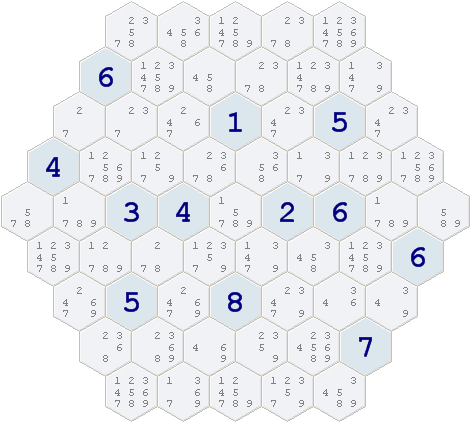Difference between revisions of "Hanidoku"
From Sudopedia
Jump to navigationJump to search (Created page with "Hanidoku example|right '''Hanidoku''' is a Sudoku Variant which uses hexagonal cells. The image shows a Hanidoku example. Every horizontal, inclinin...") |
|||
| Line 2: | Line 2: | ||
'''Hanidoku''' is a [[Sudoku Variant]] which uses hexagonal cells. | '''Hanidoku''' is a [[Sudoku Variant]] which uses hexagonal cells. | ||
The image shows a Hanidoku example. Every horizontal, inclining diagonal and descending diagonal line must contain a consecutive series of digits. Because these lines are different in size, they do not all contain digits 1 through 9. Some may contain digits 1 through 5, others may contain digits 5 through 9. This adds a level of difficulty that you will not encounter in a regular Sudoku. Fortunately, there are no boxes that you have to take into account. | The image shows a Hanidoku example. Every horizontal, inclining diagonal and descending diagonal line must contain a consecutive series of digits. Because these lines are different in size, they do not all contain digits 1 through 9. Some may contain digits 1 through 5, others may contain digits 5 through 9. This adds a level of difficulty that you will not encounter in a regular Sudoku. Fortunately, there are no boxes that you have to take into account. | ||
| − | |||
| − | |||
| − | |||
| − | |||
== See Also == | == See Also == | ||
Latest revision as of 03:37, 20 January 2022
Hanidoku is a Sudoku Variant which uses hexagonal cells. The image shows a Hanidoku example. Every horizontal, inclining diagonal and descending diagonal line must contain a consecutive series of digits. Because these lines are different in size, they do not all contain digits 1 through 9. Some may contain digits 1 through 5, others may contain digits 5 through 9. This adds a level of difficulty that you will not encounter in a regular Sudoku. Fortunately, there are no boxes that you have to take into account.
